


Variety AZT™
Variety AZT™: Cloned Quality and Uniformity
More than two decades ago, desert adapted landscape trees began gaining in popularity in southwestern landscape designs. Promoted primarily as an alternative to higher water demanding trees, landscape architects soon realized that desert trees could be used in both naturalistic re-creations of desert scenes and highly formal, more traditional landscape designs. Desert species grown from seed offered designers trees with widely varying forms and structures that would easily and naturally mimic trees found in the surrounding desert. Formal or urban landscape designs called for trees with more uniform qualities and far less heterogeneous shapes and growth habits. Such trees could not be produced if propagated from collected seeds.
An alternative to seed production is vegetative propagation (also called clonal propagation or cloning). With cloning, plant parts (typically fresh, lush, green stem growth) are treated with plant growth hormones to encourage the formation of roots. Once rooted cuttings are then grown like seedlings to produce new trees. In this way new plants, identical to the original "mother" plant, are produced. Rooting plant parts insures greater uniformity and reduces the need for repeated culling to remove seedlings with undesirable qualities. Cloning provides a useful method for producing large numbers of genetically uniform trees with similar form, structure, flower color, leaf pattern or any other desired quality or appearance. The challenge in bringing cloned trees to the market has always been to 1) select trees with the desired physical characteristics (branch structure, flower color and amount, foliage) that also possessed sound horticultural qualities (well-distributed root mass, cold hardiness, growth rate and form) and 2) to successfully and efficiently produce these clones on a large scale. Careful selection and evaluation of foundation stock (“mother” plants) in conjunction with cloning techniques can improve tree performance. Without careful screening, physically attractive trees can be introduced that are, in fact, genetically vulnerable to an assortment of unanticipated problems.
Arid Zone Trees (‘AZT™’ ) began its research on cloning desert trees with two principles in mind. First, that there are many individual trees within a desert tree specie that may exhibit desirable characteristics for landscape applications. And second, that all trees developed and marketed by ‘AZT™’ need to possess both desirable physical and horticultural characteristics. To satisfy both goals we embraced a multiple clone approach. By identifying a number of trees from within a single specie with desirable characteristics, we can offer uniformity while maintaining some genetic diversity. The search for new trees to clone continues and offers the opportunity to introduce new clones when suitable selections are identified.
We use the ‘AZT™’ variety name on all our cloned trees to allow us to add new selections as they are identified while still assuring our clients that all selections are the product of our screening and evaluation process.
All ‘AZT™’ varieties epitomize Arid Zone Trees’ commitment to quality and innovation.
Acacia smallii ‘AZT™’, AZT™ Sweet Acacia.
Sweet Acacias are popular and well-adapted shade trees for arid region landscapes. Fragrant flowers, upright stature and rapid growth rate makes it desirable for commercial and residential landscapes. It is used as a theme tree in streetscape planting or at development entries but is probably used most often as individual accent trees in mixed desert planting. Most of the literature reports that trees mature to a height of 15’ to 30’. Our experience has been that trees may reach 35’ to 45’ and may be 30’ wide.
Historically, seed grown Sweet Acacia have exhibited an unprecedented assortment of critical horticultural characteristics. Some variations, like canopy and leaf density, bark texture, have had little impact on tree longevity or durability. Wide and significant differences in cold hardiness have lead to catastrophic damage to these trees during periodic severe desert freezes. Like all Variety ‘AZT™’ selections, Acacia smallii, ‘AZT™’ is propagated from cuttings (cloned) and is the product of an extensive screening process that begins with horticultural qualities, like cold hardiness, rooting characteristics and overall durability. Once these qualities are identified we look for those potential Mother trees whose physical appearance reflect the natural beauty that have made Sweet Acacia and landscape staple in desert landscapes. Acacia smallii ‘AZT™’ is our most recent addition to our expanding inventory of cloned desert trees.

Parkinsonia (Cercidium) Hybrid ‘AZT™’, ‘AZT™’ Thornless hybrid Palo Verde.
This thornless Palo Verde hybrid exhibits qualities found in Palo Brea, Blue and Mexican Palo Verde. The canopy is lush green and provides ample shade. The characteristics that set this ‘AZT™’ clone apart from seed selections are distinctive rich, green trunks and branches that, similar to the Palo Brea, remain smooth as they mature, the absence of thorns, semi-evergreen growth and brilliant yellow flowers that appear abundantly in spring and intermittently during the summer months.


Parkinsonia (Cercidium) praecox ‘AZT™’, ‘AZT™’ Sonoran Palo Verde.
These Palo Brea clones have dark blue-green leaves and trunks. They produce brilliant yellow blooms that appear abundantly in spring and intermittently during the summer and fall months. The characteristic that sets this ‘AZT™’ clone apart from seed selections is increased cold hardiness to the upper teens to low 20’s F.
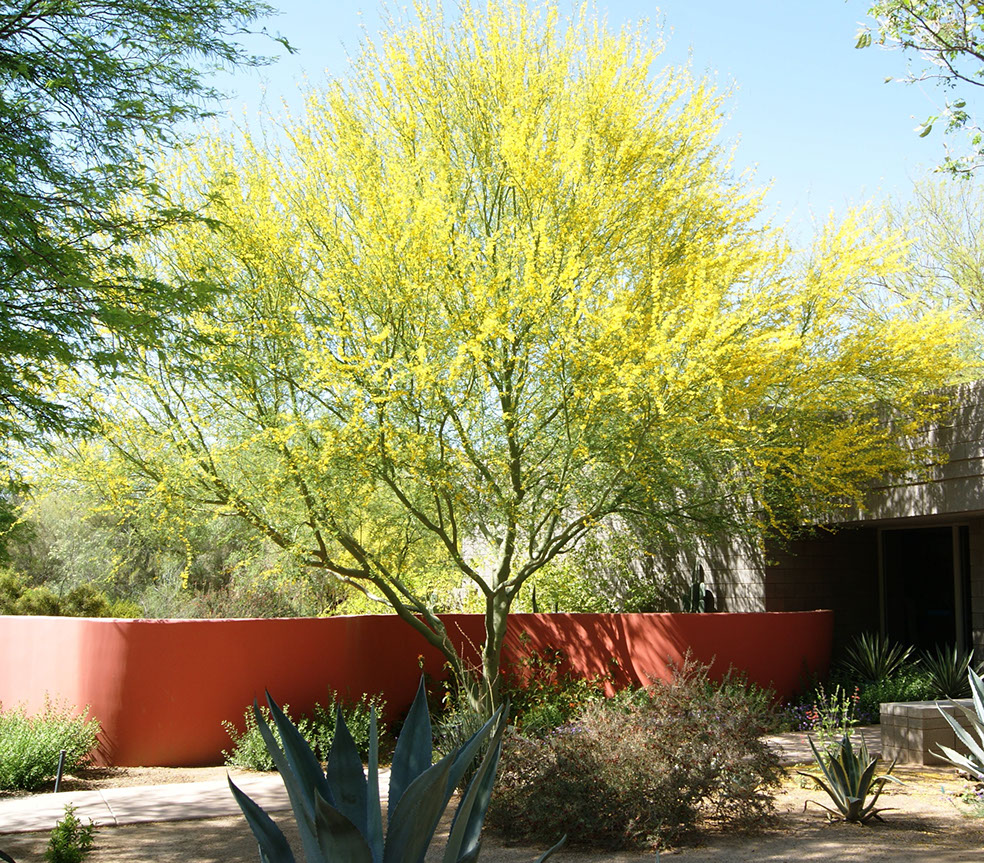

Chilopsis linearis ‘AZT™ Bi-Color’, ‘AZT™ Bi-Color’ Desert Willow.
The ‘AZT™ Bi-Color’ produces abundant blooms during the growing season against a canopy of narrow, weepy, deep green leaves making the tree a colorful and striking addition to the landscape. The floral characteristic that sets this ‘AZT™’ clone apart from seed selections are burgundy colored petals contrasting with a pink throat.
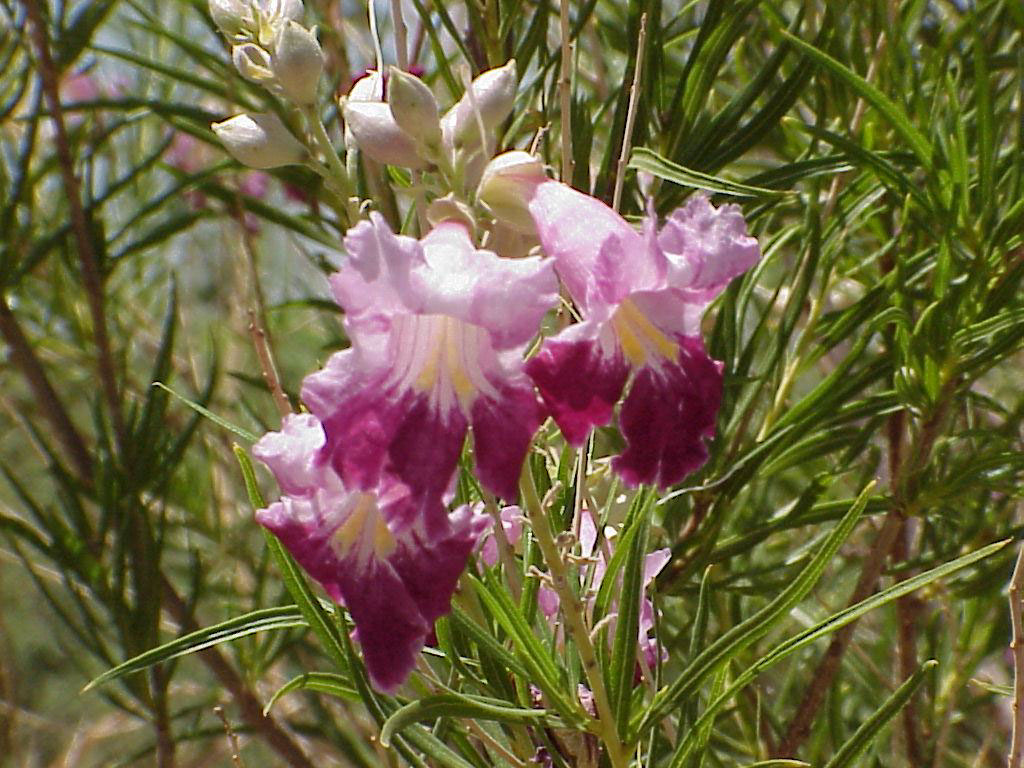
Chilopsis linearis ‘AZT™ Desert Amethyst’, ‘AZT™ Desert Amethyst’ Desert Willow.
The characteristics that set this ‘AZT™’ clone apart from seed selections are the solid-colored, dark lavender flowers combined with wider, more upright leaves. ‘AZT™’ Desert Amethyst’, like ‘AZT™ Bi-Color’, brings generous shade and much needed summer color to desert landscapes.

Chilopsis linearis ‘AZT™ Dora’s Desert Rose’, ‘AZT™ Dora’s Desert Rose’ Desert Willow.
‘Dora's Desert Rose' takes its name from an inspirational gardener who always found a place to enhance her surrounding, no matter how modest, with a garden of roses. The characteristics that set this ‘AZT’ clone apart from seed selections are the pink flower petals accented with a blush of purple and yellow and few seed pods. The leaves are wider, and held more upright. The 'AZT Dora's Desert Rose' produces abundant blooms during the growing season against a canopy of weepy, deep green leaves making the tree a colorful and striking addition to the landscape. Like ‘AZT Desert Amethyst’, and ‘AZT Bi-Color’, 'AZT Dora's Desert Rose', brings generous shade and much needed summer color to desert landscapes.
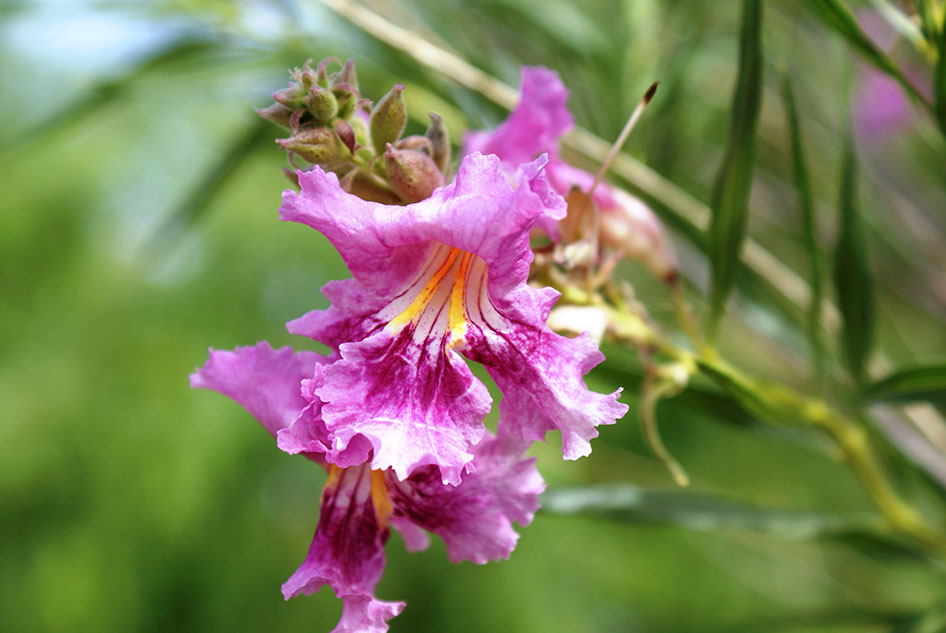
Olneya tesota ‘AZT™’, ‘AZT™’ Desert Ironwood.
The characteristics that sets this ‘AZT™’ clone apart from seed selections are faster growth with a v-shaped, upright form and larger leaflets while retaining the graceful, chalk-gray trunks and branches.
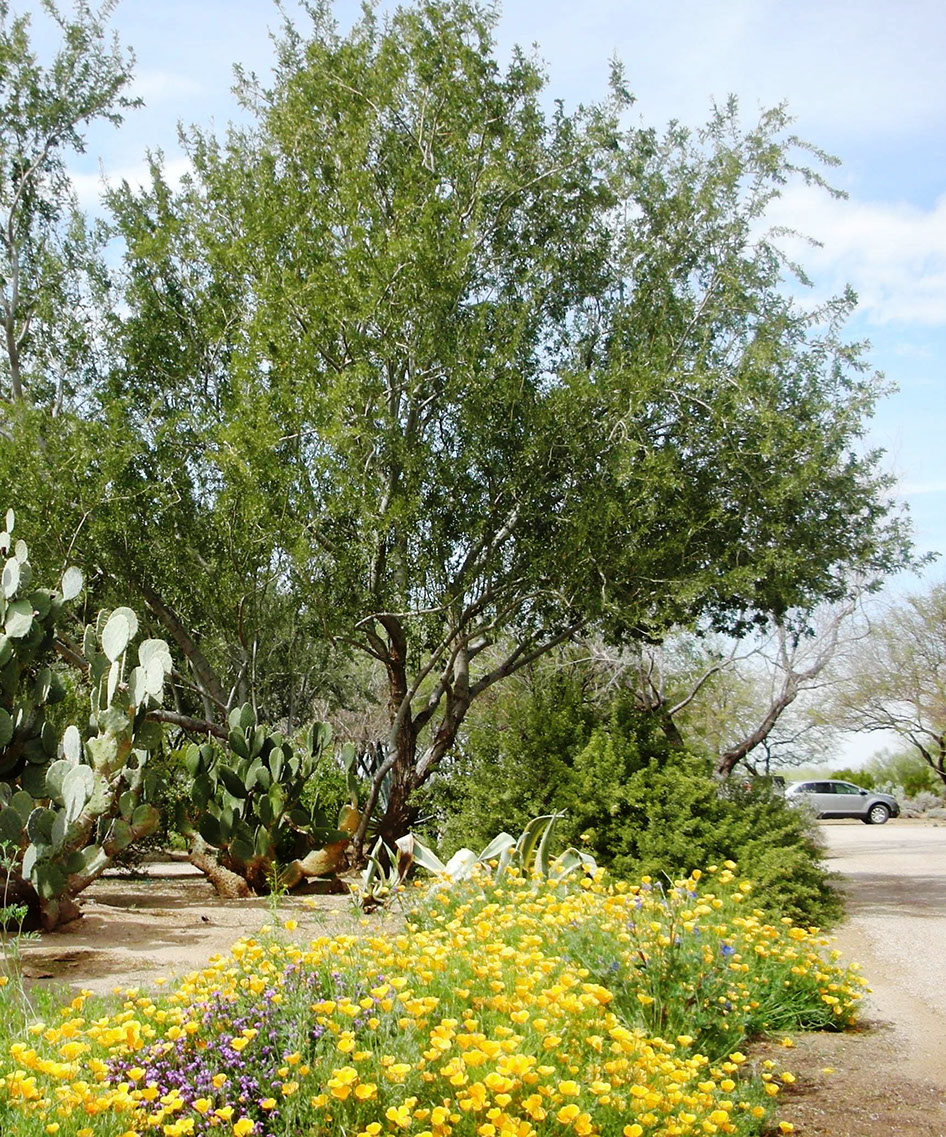
Prosopis juliflora (velutina) ‘AZT™’, ‘AZT™’ Native Mesquite.
There is much disagreement within the botanical and horticultural literature as to what constitutes an authentic Native Mesquite. Some suggest that the tree is, in reality, Prosopis velutina while others support claims that it is Prosopis juliflora. In contrast, the literature on the genus Prosopis generally agrees that nearly all the “species” within this genus freely hybridize and that many documented species are likely hybrids that can attribute their distinction to the area or region where they were studied and described. Scientific controversies notwithstanding Native Mesquite, however one chooses to define it, is among the most commonly found trees in the Sonoran desert. We began developing Prosopis juliflora (velutina) ‘AZT™’, ‘AZT™’ Native Mesquite, in part, to try to address some of this confusion and to bring greater uniformity in growth and form to this remarkable, uniquely Sonoran desert tree. Additionally, this ‘AZT™’ variety is less attractive to vector insects (aphids, thrip, whiteflies or psyllids) reducing or completely eliminating the need for seasonal pesticide applications to control these pests.

Prosopis thornless glandulosa ‘AZT™’, ‘AZT™’ Thornless Honey Mesquite.
The P. glandulosa thornless ‘AZT™’ exhibits characteristics very similar to the P. glandulosa with its willow-like appearance, delicate leaf canopy and grayish sculptural trunk. The characteristic and main attraction that sets this ‘AZT™’ clone apart from seed selections is the absence of thorns on the gently curving branches, the trees synchronous bud break and uniform growth between specimen. In the landscape setting, the tree grows at a moderate to fast rate to a mature height of 25’ to 35’ and 30’ to 40’ wide. The absence of thorns makes Prosopis glandulosa thornless ‘AZT™’ ideal for landscape applications from re-vegetation of disturbed desert sites to streetscapes, park plantings and commercial and residential landscapes. The form and texture of Prosopis glandulosa thornless ‘AZT™’ blend almost seamlessly with surrounding native Sonoran desert trees and shrubs.

Prosopis seedless hybrid ‘AZT™’, ‘AZT™’ Seedless Hybrid Mesquite.
These trees exhibit a uniform appearance, upright growth and strong branch angles. Leaflets give the canopy a lush dark green look. The characteristics that set this ‘AZT™’ clone variety apart from all other seed or cloned selections is that even though it produces a few flowers it does not set seed pods (is seedless), uniform upright growth, synchronous bud break and, with sound horticultural practices, root mass growth that is in proportion to canopy growth. This tree grows at a moderate rate. The Prosopis seedless hybrid ‘AZT™” produce no seed, making them ideal for landscape applications from re-vegetation of disturbed desert sites to streetscapes, park plantings and commercial and residential landscapes. Trees are semi-deciduous losing only a portion of the leaves in warmer winter locations. Leaves remaining through the winter are shed rapidly in spring just prior to bud break. In late spring this Mesquites produces a few yellow-green, unremarkable, catkin-like flowers that are sterile. By early summer other varieties of Mesquites will produce seed pods and shed them to the ground while Prosopis seedless hybrid ‘AZT™’ is a clean, no mess, non-fruit bearing tree. The shade produced by Prosopis seedless hybrid ‘AZT™’ can range from filtered to quite dense. Shade is a welcome addition to all desert landscapes but may inhibit the growth and flower production of under-story plantings. Carefully consider the ultimate shade that can be produced by these trees and the impact of shade on the growth and flowering of under-story plants and turf.
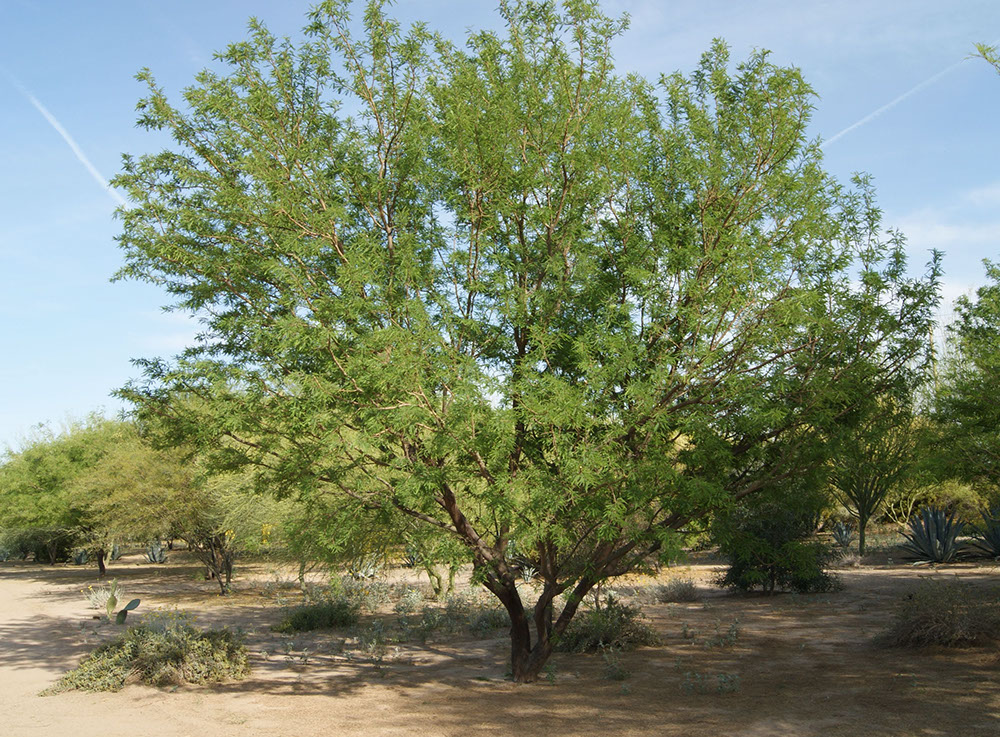
Prosopis thornless hybrid ‘AZT™’ , ‘AZT™’ Thornless Mesquite.
These trees exhibit a uniform appearance, upright growth and strong branch angles. Leaflets give the canopy a lush green look. The characteristics that set these ‘AZT™’ clones apart from seed selections are the thornless, uniform upright growth and, with sound horticultural practices, root mass growth that is in proportion to canopy growth.
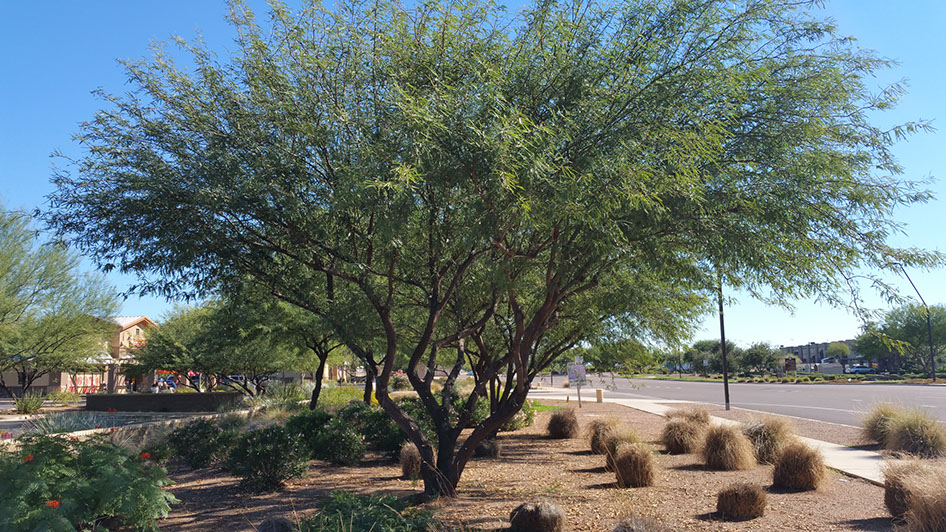
Nothing heralds the arrival of the desert spring (and in some years 100 degree temperatures) as brilliantly and conspicuously as the blooming of the Palo Verdes. With a succession that includes Blue, Foothill, Mexican and Sonoran, Palo Verdes color the desert a brilliant yellow from spring to early summer. Other than Mexican Palo Verde (Parkinsonia aculeata) all the Palo Verdes are popular and widely used landscape trees.
In the late 1970's Mark Dimmitt with the Arizona Sonora Desert Museum (ASDM) began noticing Blue Palo Verdes that exhibited characteristics suggesting they were hybrids of other Palo Verde species. After several years of observation and evaluation, Dimmitt identified a thornless seedling as clearly superior to the others collected. Careful evaluation of the genetic composition of this hybrid, named 'Desert Museum', revealed it to be a complex hybrid having genetic characteristics from Mexican, Blue and Foothill Palo Verde. Dimmitt suspects that 'Desert Museum' gets it vigorous growth, sturdy, upright branching habit and bright flowers from Parkinsonia aculeata, and its small delicate leaves from the Parkinsonia (Cercidium ) species. Trees have tolerated temperatures of 15 degrees without damage in Tucson. The most remarkable and unique feature of this hybrid is the absence of thorns. Flowers are slightly larger than those of Parkinsonia aculeata and other Parkinsonia (Cercidium) and trees have been observed to flower abundantly as early as mid-March in southern Arizona with intense, full bloom lasting into late spring and early summer. Intermittent flowering can continue into the mid to late fall. The v-shaped branching, thornless growth and ample shade make ‘Desert Museum’ a pedestrian friendly desert adapted tree that can and is used in a wide array of landscape applications.
The introduction of the ‘Desert Museum’ to the landscape market in 1987 encouraged other landscape professionals to look for other Parkinsonia (Cercidium) hybrids that exhibited phenotypes that would expand the desert landscape palette. Parkinsonia (Cercidium) Hybrid 'AZT™', a thornless Palo Verde hybrid, exhibits qualities found in Palo Brea, Blue and Mexican Palo Verde. The canopy provides ample shade with lush, green leaves. Trees are thornless and produce brilliant yellow flowers abundantly in spring and intermittently during the summer months and occasionally in the fall. Similar to the Palo Brea, the branches and trunks of the Parkinsonia (Cercidium) Hybrid 'AZT™' remain a smooth lime green as they mature. Branches are arranged in a graceful candelabra form. The orientation and angles of branches are also reminiscent of Palo Brea making the trees excellent single specimens, theme trees, street and perimeter planting and can be dramatically up-lit at night. Tiny leaflets generate minimal leaf litter that easily vanish into most rock surface mulches. These highly divided leaves produce a canopy that it lush yet airy and provides filtered shade that promotes flowering of under-story shrubs and groundcovers. Both 'Desert Museum' and C. Hybrid 'AZT™' are effective and dramatic accent or "focal point" specimen trees, ideal for streetscape and parking lot plantings or anywhere a desert look and filtered shade are needed.
Arid Zone Trees propagates 'Desert Museum' with the guidance and permission of the Arizona Sonora Desert Museum. Parkinsonia (Cercidium) Hybrid 'AZT™' is propagated and available exclusively from Arid Zone Trees.
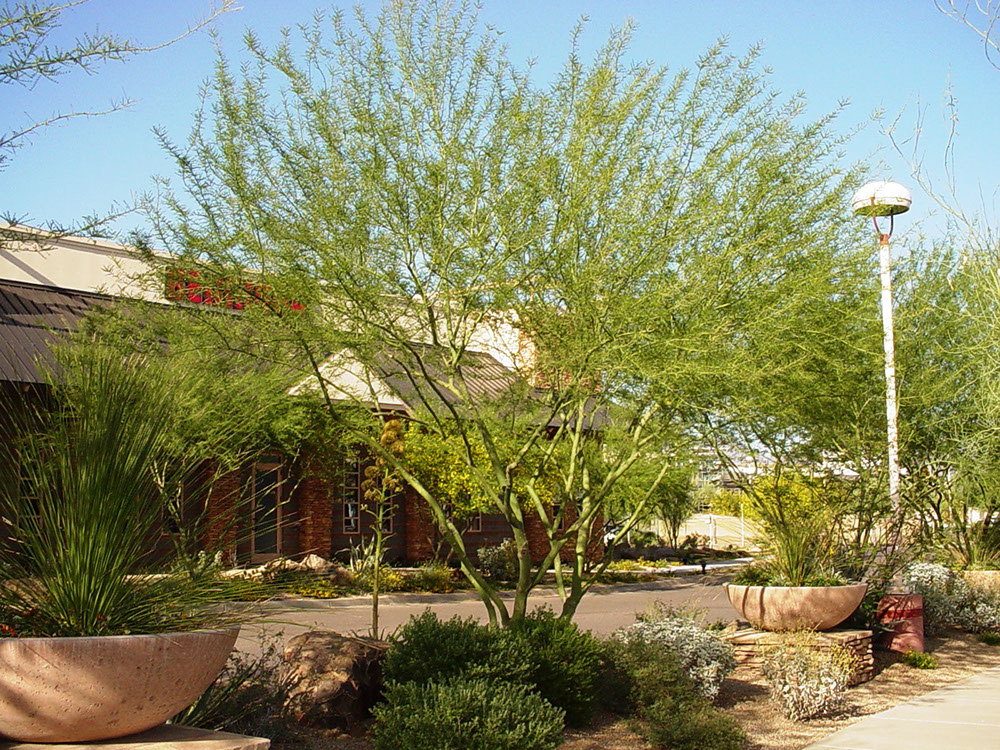

© Copyright 2000-2020 Arid Zone Trees